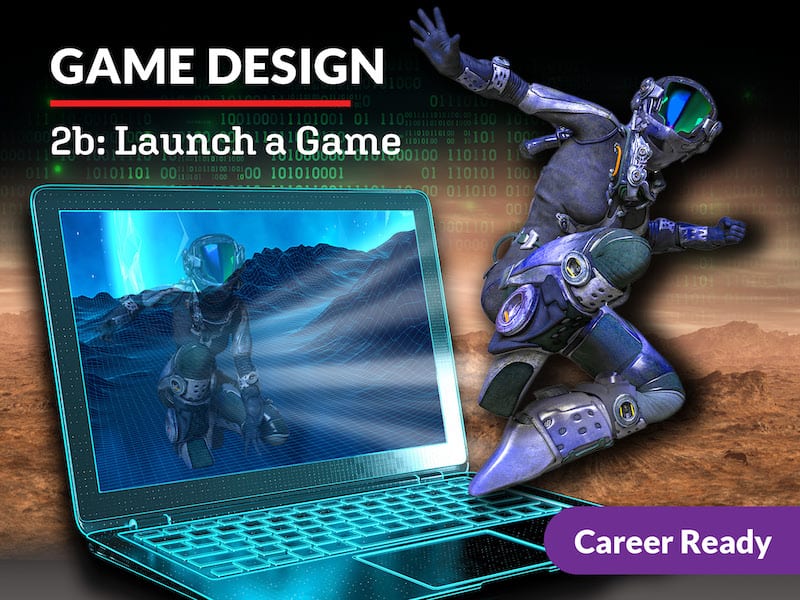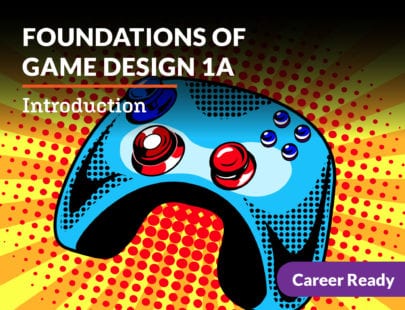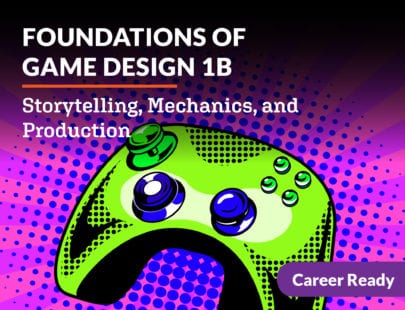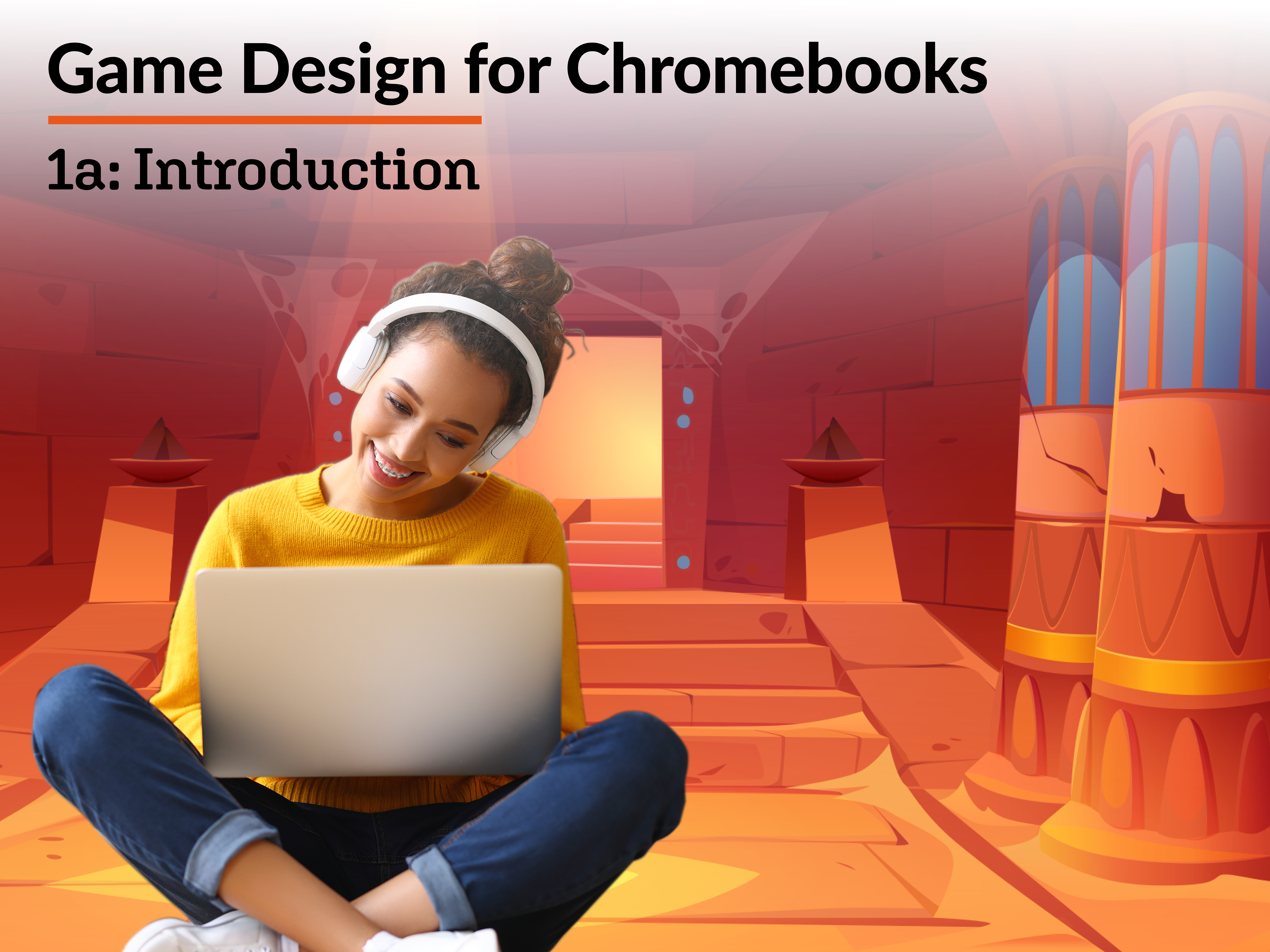
Game Design 2b: Launch a Game
You’ve already done the groundwork, and now it’s time to level up and launch! In Game Design 2b, you’ll take your runner game to new heights and enter the land of fire and ice using the cool tools that Unity has to offer! Get ready to build atmospheric landscapes, mountain runs, stair builds, and implement obstacles to keep your relic safe! Then, your real-world game begins: test and evaluate your game and prepare for a market launch! All of the moving parts of the game development process come together in this course, so you can unleash your game into the world!
Units at a Glance
Unit 1: Taking Control
It’s time to turn our basic sphere mesh into a fully animated humanoid model and learn all of the fun new mechanics that come along with it. We will also take a look at some of the other standard game modes and templates that Unity has to offer. These starting templates are the backbone of many of today’s popular games. Tired of the boring color-block meshes and ready to move onto something a bit more visually impressive? We will create new levels with 3D assets and materials that bring a sense of realism to our game. First, we’ll install the Unity Standard Assets pack and take a look at the different game controllers that we have access to and can customize for our games. We’ll then go all-in on the third person game controller and revisit some of the assets we created in the previous course.
What will you learn in this unit?
- Identify and implement Unity standardized templates and assets
- Implement humanoid character controllers
- Test out non-humanoid controllers and AI functions
- Explain how game controllers can be used to add to and enhance different game genres
Unit 2: Characters in Games
Now that we’ve gone over game controllers, let’s take a look at exactly who we’ll be controlling. We’ll begin by exploring the various archetypes in literature and how they relate to game design. Then we’ll choose an archetype to mold our character after and, with that information, choose an avatar to represent the main protagonist. You’ll learn how to implement this new avatar in Unity and integrate the character’s information and backstory into a character sheet that we’ll be adding to our Game Design Document.
What will you learn in this unit?
- Identify and describe common archetypes in literature
- Define archetypes and stereotypes common in video games
- Implement new character models from the Unity Marketplace and Adobe Mixamo into existing Unity character controllers
- Develop a backstory and create character sheets for our main protagonist and antagonist
Unit 3: Introduction to Level Design
How do you create a level that engages the player? Implementing thoughtful level design that creates complex and interesting obstacles is possible even for beginners. A variety of inventory systems used in different game genres can enhance gameplay, as do the various programming concepts needed to create these inventory systems. Specifically, we’ll learn the pros and cons of using various data storage methods like arrays, lists, and hashtables to add interest to our level. Then, we’ll return to our project and create a glowing orb for our player to collect and visually equip it to the character.
What will you learn in this unit?
- Describe how level design contributes to player interaction and enhances player actions
- Explain industry-standard methods used to create and manage inventory systems and how these systems can affect gameplay
- Program using various data storage methods within C# including arrays, lists, and hashtables
- Implement a visual inventory and item collection system within your game project
Unit 4: Extending Unity
We’ve learned the basics of the tools built into Unity, but many studios rely on advanced external tools to create their games. So how do we extend the functionality of Unity so we can harness these same powerful features? Step inside and learn tools of the trade like ProBuilder, used to create and edit 3D models within the Unity Editor. Turn regular C# code into a visual scripting flow machine using Bolt. Explore third-party extensions and templates, as well as official documentation, to help us along our programming journey. We’ll also take a look at software engineering principles and how they relate to games and game design as a process.
What will you learn in this unit?
- Describe how packages are allocated within Unity and how to enable/disable them within an existing project
- Install and use ProBuilder to create and edit 3D models for use within your scene
- Install and use Bolt to create a script and explain how visual scripting works as an alternative to C#
- Explain the principles of game design and how official and unofficial documentation is used in game development
Unit 5: Finishing Touches
Want to really make your game stand out? Learn how to use some of the most powerful tools in Unity to create unique landscape features—like mountains, hills, and plateaus—then texture them to match your game theme. We’ll create a dynamic lava system using custom particle systems and math-based script systems. Once our lava looks menacing enough, we’ll learn how to reset the stage if the player accidentally touches it. We’ll also learn about abilities. We’ll create a new pickup that allows us to cast an icy projectile at our foes, and then add an animation so our player character can celebrate their newfound powers!
What will you learn in this unit?
- Create aesthetically pleasing and diverse environments using textures, terrains, 3D models, and particle systems
- Program and design pickup objects and physics-based projectiles
- Describe class constructors and scripted inheritance, and use scripting and object-oriented programming to add new abilities and animations to your game
- Edit particle systems to create unique new effects to use in your game projects
Unit 6: Enemies, Interfaces, and Testing
It’s time to meet your match! Get ready to face off with your enemy. Here, we’ll set our character and enemy interactions and fine-tune our player’s abilities. We’ll learn about user interface elements and how they affect gameplay and relay information to the player. We’ll look at a few iconic title screens from gaming’s history and analyze what makes them great before moving on to create our very own. Finally, we’ll learn the ins and outs of alpha testing and how to document bugs and code during these stages. Let’s roll!
What will you learn in this unit?
- Create dynamic interactions between characters, enemies, and projectiles
- Design functional user interfaces and differentiate between different types of UI elements including diegetic, non-diegetic, spatial, and meta elements
- Explain how a start screen can set the tone of a game and even teach a player before they begin playing
- Document alpha testing tickets and understand the important elements of proper alpha testing
Unit 7: Betas, Packaging, and Publishing
We’ve done our internal testing, now it’s time to go public! Let’s explore the benefits of public beta testing, along with guidelines and examples of best practices to get the most out of its stages. We’ll then go over how to package games for various systems, consoles, and devices and package our game for our current operating system. Finally, we’ll move into the various release stages and review valuable information about the types of publishing you may want to consider when releasing your own games.
What will you learn in this unit?
- Learn how to package your game for modern operating systems and devices
- Describe the stages of beta testing and their specific applications and purpose
- Explain the publishing methods available to a game and the costs and benefits of each
- Identify the different release stages and why some games might be better suited for different types of releases
Unit 8: Marketing and Supporting Your Game
Congratulations! You’ve almost made it. While your game might be ready, your development journey is likely just beginning. Let’s look at what to expect after releasing your game, handling good and bad reviews, using current advertising practices to realistically set up your game for success, monetizing properly to keep your development team funded for future projects, releasing additional content and updates, and leveraging your game’s new audience to help the success of future projects. Essentially, we will learn how to get the absolute most out of your hard work and the achievement of creating a game project!
What will you learn in this unit?
- Discuss what to expect after release and how to apply constructive criticism and monetization
- Explain branding and create marketing materials like cover art
- Evaluate the influence and costs of different types of marketing and advertising on the success of a game
- Plan for continued updates and content and leverage your current audience for future projects
Required Materials
Software
- UnityLTS Release 2019.4.8f1 (requires login)
- Word processing software
- Google Drawings(requires login)
- Graphic design software
Other
- Helper



